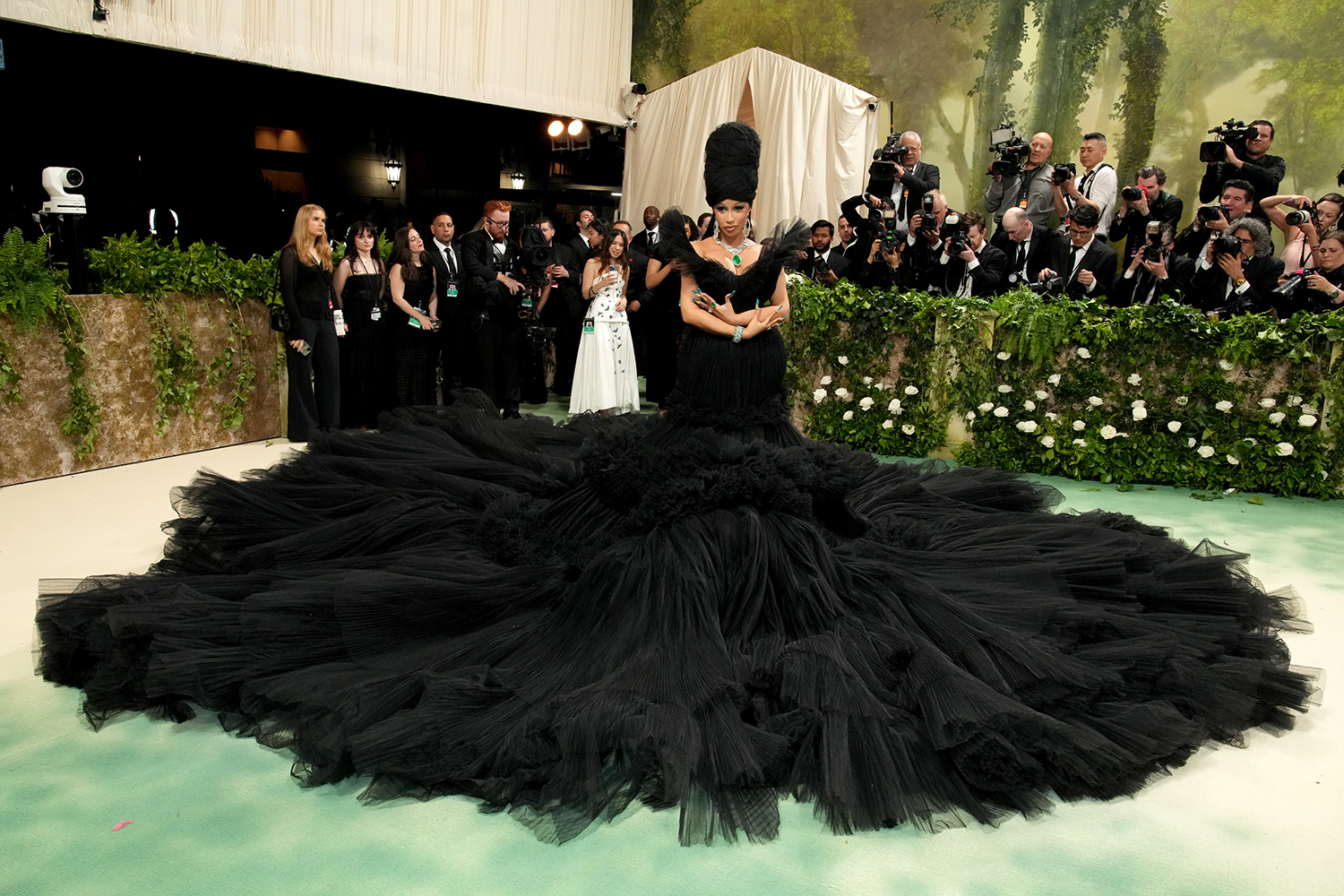On May 6, celebrities waltzed into the Metropolitan Museum of Art for the year’s biggest night of fashion, extravagance and outrageous displays of wealth: The Met Gala.
One ticket to the Met Gala costs around $75,000, which the BBC points out is “more than the average down payment on a house.” The proceeds serve as a fundraiser for the museum, and at this price, only the wealthiest of celebrities get to donate.
Atop the ticket price, celebrities in attendance spend thousands crafting outfits to wear to the gala, designing them to fit in with the theme, which coincides with the Met’s Costume Institute exhibition. This year’s theme, “The Garden of Time,” complemented an exhibit titled “Sleeping Beauties: Reawakening Fashion” that showcases a collection of famous designer fashion garments from throughout history, many of them old, fragile and ornately decorated.

Mallory Challis
In line with this theme, gala guests came dressed in extravagant clothing reminiscent of a garden party. And in classic Met Gala fashion, these outfits were outrageous.
Journalists annually cover the Met Gala, offering commentary on celebrity looks, interviewing them about the getting ready process or ranking outfits based on how well they adhere to the theme.
And with the rise of social media, it has become a tradition for users to review Met Gala looks too. Users often categorize them as boring, could’ve-been-better, outrageous-yet-impressive or downright insane in lighthearted posts, blogs or videos.
But while they continue the trend again this year, world politics seems to have made its way into the conversation.
This year, social media users are critiquing celebrities not only on how fashionable or wearable their gala outfits might be — such as ample commentary on Kim K’s dangerously small corset — but also by pointing out how their extravagant expressions of wealth seem tone-deaf given the context of the war in Gaza, specifically regarding the humanitarian crisis among civilians.
While celebrities carelessly spend millions on just one night out, families and children in Gaza are dying of violence and famine amid the ongoing war between Israel and Hamas.
And social media users have seen this before.
This extravagance, they say, seems eerily similar to the capital citizens in District One of the Hunger Games series, who tout their outrageously fashionable outfits and unreasonable wealth while the rest of society very clearly and publicly suffers extreme conditions of hunger and violence. Conditions that, in the Hunger Games stories, are caused by war and imposed upon innocent civilians. Just like the situation in Gaza.

Cardi B attends the 2024 Met Gala Celebrating “Sleeping Beauties: Reawakening Fashion” at The Metropolitan Museum of Art on May 6, 2024, in New York City. (Photo by Jeff Kravitz/FilmMagic)
A ‘full-blown famine’
According to Cindy McCain, head of the United Nations World Food Program, the conditions in Northern Gaza are now considered a “full-blown famine” as a result of the war between Israel and Hamas.
The war was triggered when Hamas, a Palestinian militant group that often occupies the Gaza Strip, launched a surprise attack on Israel, killing 1,200 people and taking about 240 Israeli citizens captive. In response, Israel declared war and began using retaliatory force against Hamas.
According to Gaza’s Ministry of Health, at least 34,654 Palestinians have died and 77,908 have been wounded since Oct. 7, not only due to attacks, but due to hunger, starvation and a famine in Northern Gaza..
The population in Gaza alone is currently around 2.3 million.
Although multiple countries and humanitarian aid groups across the world are trying to respond to Gaza’s hunger crisis, mostly by delivering food and other resources by air, due to levels of violence in the area, the rate at which groups can provide aid is not fast enough given the catastrophic state of famine.
In fact, a report published in March by the Integrated Food Security Classification, which partners with the World Food Program, predicted famine was “imminent” in Northern Gaza and would likely occur between mid-March and May 2024 if conditions did not improve. This condition is classified as phase 5 “catastrophic” hunger.
The report noted part of the reason hunger would be so extreme is due to the projected inability of humanitarian organizations to reach Northern Gaza to deliver supplies, such as food, water or even sanitation materials and medical supplies.
And given the World Food Program’s declaration of famine in the area this May, the Integrated Food Security Classification’s predictions were correct.

Displaced Palestinians are collecting food donated by a charity before an iftar meal, the breaking of the fast, before the end of the Muslim holy fasting month of Ramadan, in Rafah in the southern Gaza Strip, on April 5, 2024, amid ongoing battles between Israel and the militant group Hamas. (Photo by Majdi Fathi/NurPhoto via AP)
According to reporting by Al-Jazeera, Israel has made active efforts to restrict the delivery of this aid to civilians in Gaza, including its military having repeatedly “attacked and killed Palestinian civilians waiting to collect aid in the Strip.” They also report that Israel’s prime minister, Benjamin Netanyahu, has threatened to invade Rafah, a city in southern Gaza where many Palestinian civilians are sheltering.
Given the current state of famine in Gaza, U.S. President Joe Biden has declared he will halt shipments of American weaponry being sent to Israel if the country carries out this threat against Rafah. He reasoned that, because 1.4 million civilians currently reside in Rafah and conditions are already so dire, “it’s just wrong” to wage war in areas where civilians would be put at further risk of injury and death.
While the statement acknowledges America’s complicity in the devastation the war in Gaza has caused for Palestinian civilians, Biden also maintains that the U.S. will continue to support Israel and provide weaponry to use in defense against Hamas as a threatening militant group.

Josh Hutcherson, Elizabeth Banks and Jennifer Lawrence in The Hunger Games: Catching Fire. (Murray Close/Lionsgate)
A revolution in Panem, pro-Palestinian protests
And while the Met Gala is the most recent celebrity spectacle on our social media feeds, people all around the world are becoming increasingly frustrated with the state of the Israel-Hamas war as its violence and brutality continue to affect innocent civilians. It is no longer a spectacle easily ignored but an important reality of the world that cannot be ignored.

Adrien Brody and Georgina Chapman attend the 2024 Met Gala at The Metropolitan Museum of Art on May 6, 2024, in New York City. (Photo by Jeff Kravitz/FilmMagic)
Just as the Hunger Games protagonists demanded the outrageously dressed and disgustingly wealthy capital citizens of District One take conditions of suffering and starvation across Panem seriously, worldwide onlookers to the war in Gaza are making similar demands on behalf of Palestinian civilians suffering this famine.
Social media campaigns are raising money to provide more aid to the Gaza Strip. Community organizers are sharing updated information about the war to keep those around them informed. College students across the U.S. are organizing protests on their campuses and demanding school administrations divest financial ties with companies that support Israel.
In the shadow of the Met Gala’s extravagance, many fans of celebrities in attendance are protesting by unfollowing, unsubscribing or cutting off support for them, hoping their actions will bring this issue to the attention of the real-life “District One.”
And as the globe watches the catastrophic famine in Gaza grow worse, violence on both sides continues and devastation from a long-held history of cultural tension unfold, social media users bring to the fore this question: How can we focus on a multi-million dollar, one-night event displaying ridiculously expensive and outrageously unwearable fashion statements while most civilians in the Gaza Strip cannot even access food?
Protesters want onlookers to know that, while these million-dollar outfits may be fun to joke about online, for civilians in Gaza, hunger is not a game.
Mallory Challis is a master of divinity student at Wake Forest University School of Divinity. She is a former BNG Clemons Fellow.
Related article:
What happens when the snow melts? Humanizing victims of the war in Gaza with The Ballad of Songbirds and Snakes | Opinion by Mallory Challis


